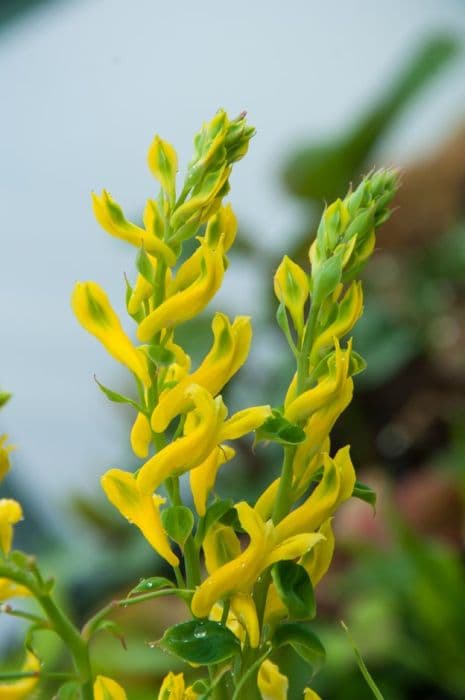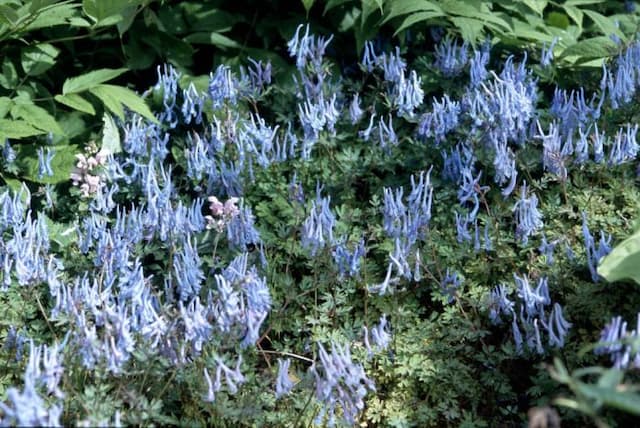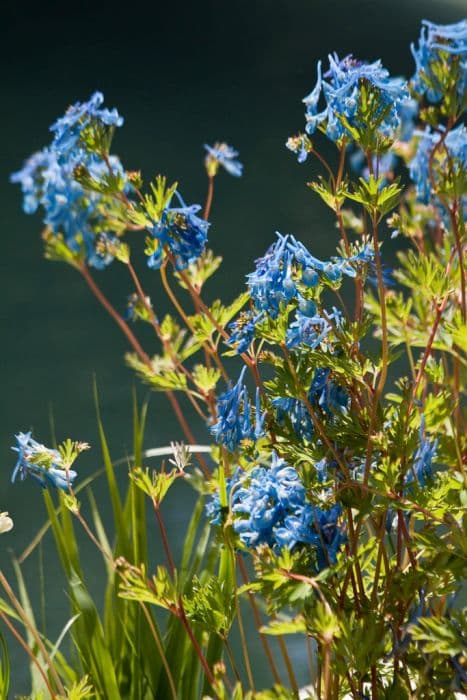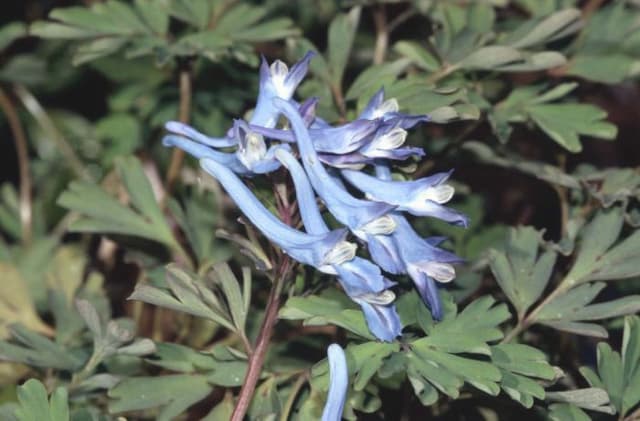Fumewort 'George Baker' Corydalis solida subsp. solida 'George Baker'
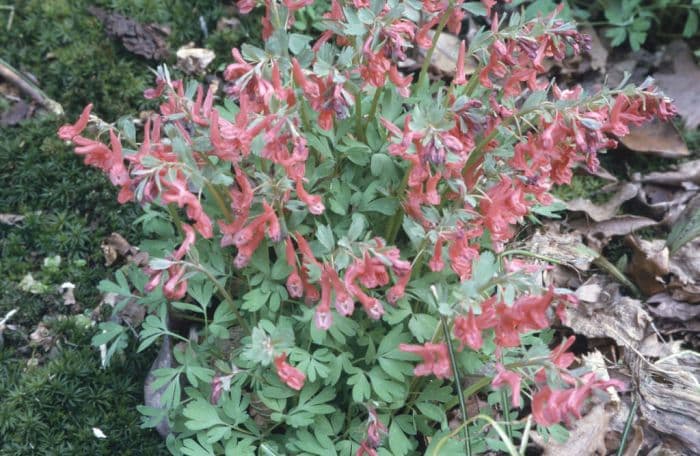
ABOUT
'George Baker' is a tuberous herbaceous perennial to 25cm, with a tuberous root and grey-green, divided foliage. Tubular, deep brick-red flowers are borne in an erect raceme
About this plant
 Names
NamesFamily
Papaveraceae
Synonyms
Fumewort, Bird-in-a-Bush
Common names
Corydalis bulbosa var. solida, Corydalis halleri, Corydalis solida.
 Characteristics
CharacteristicsLife cycle
Perennials
Foliage type
Deciduous
Color of leaves
Blue-green
Flower color
Red
Height
4-8 inches (10-20 cm)
Spread
4-6 inches (10-15 cm)
Plant type
Bulb
Hardiness zones
5
Native area
Europe
Benefits
 General Benefits
General Benefits- Aesthetic Appeal: Corydalis solida 'George Baker' adds vibrant color to gardens with its eye-catching reddish-pink flowers in early spring.
- Attracts Pollinators: This plant is appealing to bees and other pollinators, thereby supporting local ecosystems.
- Spring Bloomer: It blooms early in the spring season, providing one of the first splashes of color after winter's thaw.
- Shade Tolerance: As a woodland plant, it can thrive in partly shaded areas where other plants might struggle.
- Naturalizing: This species has the ability to spread and naturalize over time, filling in garden spaces and creating a more complete look.
- Deer and Rodent Resistance: The plant is generally resistant to deer and rodents, making it a good choice for gardens in areas with wildlife.
- Low Maintenance: Corydalis 'George Baker' requires minimal care once established, making it a good option for gardeners looking for low-maintenance plants.
- Seasonal Interest: In addition to its flowers, it can also provide interesting foliage texture in the garden.
 Medical Properties
Medical Properties Air-purifying Qualities
Air-purifying QualitiesThis plant is not specifically known for air purifying qualities.
 Other Uses
Other Uses- Corydalis solida 'George Baker' can be used as a natural dye for textiles, imparting delicate hues to fabrics.
- In landscape design, the plant is used for its aesthetic appeal to create stunning spring-time displays in rock gardens and woodland settings.
- The plant can be used in cut flower arrangements; its vibrant flowers add a pop of color to bouquets.
- For those interested in photography, the vibrant blossoms serve as an excellent subject for macro and nature photography.
- Educationally, the plant can be incorporated into botany curricula to help students learn about early spring bloomers.
- It can serve a role in conservation efforts, by planting it in areas where local flora has been diminished.
- Corydalis solida 'George Baker' seeds can be used in seed art, creating intricate patterns and mosaics with their small size.
- This plant can also be used as an indicator plant in gardens to signal the onset of spring.
- In colder climates, it can be cultivated indoors in pots to bring an early splash of color to interiors.
- The blooming of Corydalis solida 'George Baker' can be an occasion for educational nature walks, demonstrating the plant's role in the ecosystem to enthusiasts.
Interesting Facts
 Feng Shui
Feng ShuiThe plant Corydalis is not used in Feng Shui practice.
 Zodiac Sign Compitability
Zodiac Sign CompitabilityThe plant Corydalis is not used in astrology practice.
 Plant Symbolism
Plant Symbolism- Hope: Corydalis, often found emerging in early spring, is seen as a symbol of hope as it signifies the return of life after a long winter.
- Elusiveness: The ephemeral nature of Fumewort flowers, which can disappear shortly after they bloom, reflects the fleeting nature of some opportunities or joys in life.
- Consolation: With its delicate appearance, Fumewort often represents consolation, suggesting comfort in times of distress or sorrow.
 Water
WaterFumewort (Corydalis solida 'George Baker') prefers consistently moist soil during its growth period in the spring but does not like to be waterlogged. Water this plant when the top inch of soil feels dry, which might be about once a week depending on weather conditions. A good method of watering is to use a watering can to gently apply water directly to the base of the plant, avoiding wetting the foliage. During its dormant period in the summer, watering should be reduced significantly. An approximation of watering would be to provide the plant with about one gallon of water every week to ten days during the active growth phase, adjusting as needed for rainfall and temperature.
 Light
LightFumewort thrives in dappled sunlight or partial shade. The best spot for this plant would be under the canopy of deciduous trees where it can receive filtered light. Full sun can often be too intense for Fumewort and can lead to scorching of the leaves, while full shade may result in poor flowering.
 Temperature
TemperatureFumewort prefers a cool to moderate temperature range, ideally between 50°F and 75°F. It can survive winter temperatures down to about 20°F provided the ground isn't prone to repeated thawing and freezing which can heave and damage the roots. During the growth period, keeping the plant in this temperature range will promote good health and flowering.
 Pruning
PruningPruning Fumewort is generally not necessary. However, after flowering, you can remove the spent flower stems to keep the plant tidy if desired. No regular pruning schedule is required for this plant since it goes dormant in the summer, and any remaining foliage will naturally die back.
 Cleaning
CleaningAs needed
 Soil
SoilThe best soil mix for Fumewort (Corydalis solida 'George Baker') should be well-draining and fertile, with a composition of loam mixed with organic matter such as leaf mold or compost. It prefers a slightly acidic to neutral pH, ranging from 6.0 to 7.0.
 Repotting
RepottingFumewort typically does not need frequent repotting; it can be repotted every 2-3 years or when you notice that the tubers have filled up the pot.
 Humidity & Misting
Humidity & MistingFumewort prefers moderate humidity levels but can tolerate a range of conditions as long as the soil moisture is maintained and there is good air circulation.
 Suitable locations
Suitable locationsIndoor
Place Fumewort in bright, indirect light with cool temperatures.
Outdoor
Plant Fumewort in partial shade with moist, fertile soil.
Hardiness zone
3-8 USDA
 Life cycle
Life cycleCorydalis solida subsp. solida 'George Baker', commonly known as Fumewort 'George Baker', begins its life cycle in the form of a tuber, which lies dormant underground during the summer. In early spring, the tuber sprouts and gives rise to foliage and distinctive pinkish-red flowers, which attract pollinators for sexual reproduction. After flowering, the plant sets seed, which is dispersed by various means, including wind and animals. Once seeds are spread, they germinate to form new plants, completing the sexual phase of the life cycle. The foliage then dies back by late spring as the plant enters a period of dormancy, conserving energy within the tuber. This dormancy lasts until the following spring, when the cycle begins anew with the emergence of fresh shoots.
 Propogation
PropogationPropogation time
Spring
Corydalis solida subsp. solida 'George Baker', commonly known as Fumewort, is typically propagated through division of its tubers. The best time to propagate is in the summer after the foliage has died back, indicating that the plant is dormant. Carefully dig up the clump of tubers and gently pull them apart, ensuring that each division has at least one growth point. Replant the divisions immediately at the same depth they were originally growing — about 2 inches (5 centimeters) deep — and water them thoroughly. This method ensures that the distinctive color and characteristics of 'George Baker' are maintained in the new plants.
